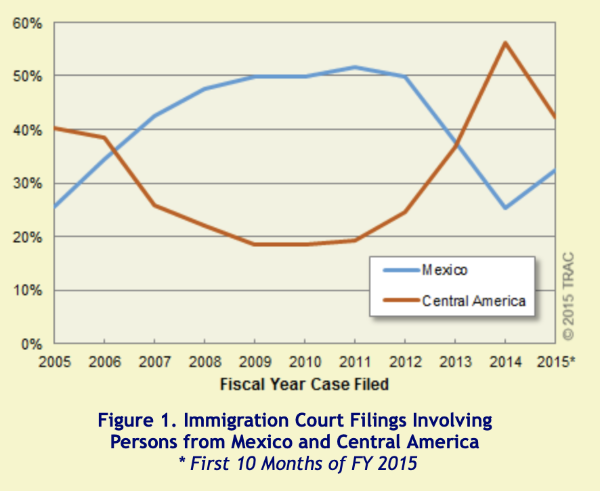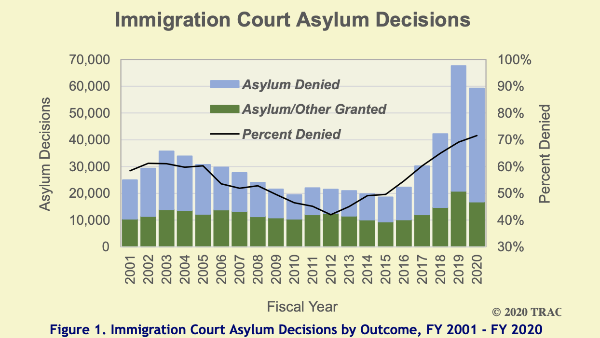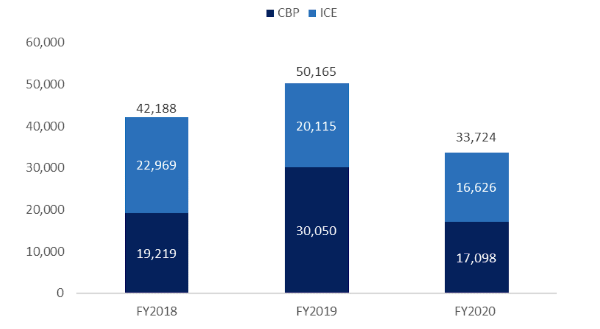A border influx is defined as a sharp increase in the number of migrants arriving at the U.S. southern border. In recent years, most have come from the Northern Triangle countries (NTC) of Honduras, Guatemala, and El Salvador in response to several drivers unrelated to the U.S. and our immigration policies. Unfortunately, certain anti-immigrant organizations and lawmakers use the changing demographics and fluctuations in arrivals of migrants to scare Americans into believing the U.S. is unable to safely process them and consider their legal asylum claims. This narrative inflames xenophobia by falsely casting increases in the number and changes in the demographics of migrants seeking protection as an uncontrolled threat to national security. Instead of sowing panic, we should take these changing asylum trends as a challenge to upgrade our processing capacity to ensure it is safe and humanitarian.
Most previous administrations have relied on deterrence policies to scare potential migrants out of the idea of coming to the U.S., focusing on expanding detention capacity, and using expedited deportation for newly arrived migrants and asylum seekers. Imposing daily caps on the number of people processed at the border (“metering”) or immediately turning them back to Mexico under the Migrant Protection Protocols were all meant to limit the entry of new migrants.
The Trump administration aimed particular vitriol towards migrant caravans, defined as large groups of people moving by land across international borders. Not only did Trump knowingly and falsely insist that caravan migrants were coming to the U.S. illegally, but he also notoriously alleged that caravans consisted of criminals and included terrorists from the Middle East intent on wreaking havoc upon arrival.
In reality, these caravans are made up of the same types of asylum seekers who have approached the U.S. in need of protection for years; traveling together simply allowed international authorities to monitor their travel. Caravans are typically organized through social media and are a way of seeking safety in numbers.
Migrants face many dangers on their journeys. Local gangs may murder, kidnap, rape, and exploit them. Smugglers, also known as coyotes, tend to charge thousands of dollars and abandon stragglers. Coyotes hide migrants in wretched houses and large vehicles on the journey, ready to quickly move to avoid authorities and gangs. Amid these perils, caravans are the most secure form of travel — even though they commonly encounter authorities along the way who attempt to break them up with physical force.
Unsurprisingly, the focus on deterrence for the past two decades has led only to increased detention capacity instead of increased processing capacity. And yet, spikes in migration in 2014, 2017, and 2020 following increasing violence and devastating regional natural disasters evidence migrants’ continued interest in seeking refuge in the U.S. Their journey is about survival.
To better address future populations of asylum seekers, we must first learn about the changing demographics of migration, prior administrations’ mistakes, and how U.S. strategies continue to exacerbate current problems.
The Obama administration (2009-2017)
During the Obama administration, the U.S. saw a sharp rise in the number of women and children seeking asylum, concentrated in 2014. In response, the administration resorted to mass arrests, detentions, and removals of undocumented immigrants.
Once in custody, migrants apprehended at the border are kept in station holding cells — temporary detention facilities — before being transferred to a long-term detention location. The administration rushed to organize temporary facilities along the U.S.-Mexico border as apprehensions and arrests surged. Texas’ converted warehouse facility became infamous when pictures were leaked showing chain-link fences separating children from their families.
Later, the Obama administration implemented Expedited Removal (ER), which immediately removed undocumented immigrants apprehended at or near the border. Those subjected to ER were temporarily detained in facilities on the border and deported without due process.
The 2014-2015 surge brought about a notable demographic shift as Central American migrants surpassed the number of Mexican migrants. Figure 1 below, based on data from the Transactional Records Access Clearinghouse (TRAC), notes the percentage of immigration court filings involving Central American nationals and Mexican nationals starting in 2005.
FIGURE 1: Immigration Court Filings by Country 2005-2015

According to this report:
This changing makeup of Immigration Court cases reflects in part the sharp peaks and valleys in the year-to-year flow of cases from Central American countries. For example, [in 2005] there was a sharp spike of 44,202 Immigration Court cases involving persons from Honduras, with another 43,608 from El Salvador. That year Central Americans made up 40 percent of all filings, exceeding the number from Mexico. Last year, there was another spike so that Central Americans made up over half (56%) of new Immigration Court cases.
The Mexican government responded to this surge by implementing the Southern Border Program (Programa Frontera Sur) in 2014 to curb migration from Central America. As the Migration Policy Institute states:
[…] Mexican apprehensions of migrants from El Salvador, Guatemala, and Honduras rose to 173,000 in FY 2015, surpassing the 134,000 such apprehensions made by U.S. immigration authorities that year… While Mexican apprehensions of migrants from these countries have since decreased, they remain higher than they were prior to the implementation of the Southern Border Program.
On the U.S. side of the border, the Obama administration ramped up the Criminal Consequence Initiative ― established under the George W. Bush administration as Operation Streamline ― which authorized the prosecution of any immigrant who crossed into the U.S. in between ports of entry.
Under the Criminal Consequence Initiative, DHS officials increased the detention of newly arrived migrants apprehended around the southern border. The administration justified the group arrests by criminalizing everyone illegally crossing the border, regardless of their legal right to claim asylum. In addition to failing to meaningfully reduce the number of migrants arriving each year, the Obama administration set the stage for the humanitarian atrocities committed during the Trump administration.
The Trump administration (2017-2021)
The Trump administration focused on halting migration by building a physical wall on the U.S.-Mexico border and a symbolic wall of policies to deter migrants from the southwest border, even for those applying for asylum. The term “border influx” was used to strike fear into Americans about the growing number of migrant caravans, used to justify draconian policies to deter migration.
One of Trump’s most infamous policies, the Migrant Protection Protocols ― otherwise known as Remain in Mexico ― assigned asylum seekers a case and court date, but barred them from waiting in the U.S. Thousands of migrants are still stranded and unprotected from poverty and gang violence in border towns awaiting processing.
Trump also expanded metering, an Obama-era policy that imposed arbitrary, daily restrictions on the number of migrants who could be processed at each port of entry. Some Customs and Border Patrol agents abused this practice, telling migrants that “Trump says we don’t have to let you in,” or that there was no more room in the U.S.
Another definitive Trump-era executive action ― the Zero Tolerance policy ― separated parents from their children, some of whom were infants and toddlers. While this brutal policy did deter some parents from crossing the border, many reluctantly sent their children to claim asylum unaccompanied. This trend resulted in a rise in unaccompanied minors processed during the Trump administration despite a drop in overall border apprehensions.
To further dissuade migrants from seeking protection in the U.S, the Trump administration also expanded the use of expedited deportation and removed protections to limit who qualified for asylum.
In Figure 2 below, TRAC reported a significant increase in annual denial rates for asylum court decisions: 54.6 percent at the end of the Obama term and 71.6 percent by the end of the Trump administration. The report also noted a growing proportion of asylum seekers who were unable to find legal representation during the Trump term. In part, this may explain the jump in denial rates as it is less likely to win these cases without the defense of a lawyer.
FIGURE 2: Immigration Court Asylum Decisions 2001-2020

The report concluded:
The odds of success in receiving asylum or an alternative form of relief continued to vary greatly by the asylum seeker’s nationality. Among the ten countries with the largest number of asylum decisions, Hondurans had the least success, with 87.3 percent of applicants who were denied. Those from Guatemala had the second lowest success rate, with 85.8 percent denied, followed by Mexicans, whose asylum applications were denied 85.0 percent of the time.
Under the guise of prioritizing public health during the pandemic, the Trump administration eventually closed the border under Title 42 and forced vulnerable asylum seekers and other immigrants to remain in the refugee camps on the Mexican side.
Most asylum seekers in the U.S. awaiting hearings did so in detention. The number of asylum seekers never detained while awaiting a hearing on their deportation case fell sharply, from 72 percent in December 2016 to 47 percent in February 2017. While waiting for their court hearings, asylum seekers are thus cut off from their loved ones and communities. Even vulnerable populations, like people with physical disabilities, are forced into facilities ill-equipped for their needs.
To house the growing number of asylum seekers — adults and children alike — the Trump administration partnered with private contractors to build new detention facilities. During this period, an additional 40 facilities were established, for a total of 220 nationwide. Over 90 percent of undocumented immigrants in detention were held in facilities owned or managed by private companies, subject to numerous ongoing lawsuits.
Many imprisoned asylum seekers find it virtually impossible to receive parole and have a 50/50 chance of being granted bonds they usually cannot afford to pay. ICE strategically places immigrants away from urban areas to prevent them from seeking legal assistance. Medical care, basic sanitary needs, and food are denied or are of inferior quality and limited quantity. The American Civil Liberties Union and many other legal rights organizations have filed several lawsuits against the Trump administration over the inhumane treatment of wrongfully detained asylum seekers.
As seen in the figure below, ICE alone detained a daily average of more than 46,000 immigrants in FY2018 and FY2019.
FIGURE 3: ICE Average Daily Detainees 2018-2020

Although FY2020 numbers did not meet expected levels due to the COVID-19 pandemic, the construction of detention facilities continued. In fact, in the week leading up to President Biden’s inauguration, the Trump administration ordered tents to be built at the border to detain unaccompanied minors in the coming months temporarily.
The Trump administration’s efforts have only demonstrated that, as with the Obama administration’s approach to the border influx, deterrence policies do not work. Expanding detention, limiting protections, and threatening migrants with the harshest conditions possible will not stop people from seeking safety.
The real lesson here is that we need our asylum system to be adaptable, capable of expanding when there is a crisis driving large numbers of people to seek protection, and contracting when arrival numbers are smaller. Those adjustments need to happen in processing capacity, not detention space.
Conclusion
Under U.S. and international law, there are no annual limits on the number of asylum seekers who can be processed. To say that our immigration system is overwhelmed or that there has been an influx crisis is to admit that our system is failing. The U.S. immigration system is meant to be adaptable, but it requires well-considered solutions rather than a reliance on tired and ineffective responses.
Photo by Barbara Zandoval on Unsplash